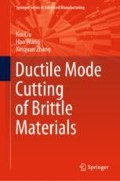Abstract
Recently, the industrial application of glass has increased enormously because of its excellent and unique mechanical, physical, chemical and optical properties. However, machining of glass is still a major problem for the manufacturing industry since it is very brittle and high hardness. In this chapter, grooving and cutting tests of soda-lime glass are conducted to evaluate its cutting performance using an ultra-precision lathe with a single crystal diamond tool. The machined workpiece surface topography, chip formation and surface roughness are examined using a SEM, AFM and white light interferometer. Tool wear is measured using OMIS. Experimental results indicate that ductile mode cutting of soda-lime glass is achieved when the undeformed chip thickness being less than a critical value. Ultrasonic vibration assisted cutting is employed to improve ductile mode cutting performance of soda-lime glass. Continuous layer chip and smooth surface are obtained in ultrasonic vibration assisted cutting of soda-lime glass, which largely improve its machinability in ductile mode cutting. But extremely short tool life is the main constrain for realizing the ultrasonic vibration assisted ductile mode cutting of glass in industry.
Access this chapter
Tax calculation will be finalised at checkout
Purchases are for personal use only
References
Huerta M, Malkin S (1976) Grinding of glass: the mechanics of the process. ASME T J Eng Ind 98:459–467
Huerta M, Malkin S (1976) Grinding of glass: surface strength and fracture strength. ASME T J Eng Ind 98:468–473
Bifano TG, Dow TA, Scattergood RO (1991) Ductile-regime grinding: a new technology for machining brittle materials. ASME T J Eng Ind 113:184–189
Namba Y, Abe M (1993) Ultra precision grinding of optical glasses to produce super-smooth surfaces. CIRP Ann 42:417–420
Takeuchi Y (1996) Ultra precision 3D micro machining of glass. CIRP Ann 45:401–404
Komanduri R (1996) On material removal mechanisms in finishing of advance ceramics and glasses. CIRP Ann 45:509–513
Brehm R, van Dun K, Teunissen JCG et al (1979) Transparent single point turning of optical glass: a phenomenological presentation. Prec Eng 1:207–213
Liu K (2002) Ductile cutting for rapid prototyping of tungsten carbide tools. NUS PhD thesis, Singapore
Liu K, Li XP (2001) Modelling of ductile cutting of tungsten carbide. T NAMRI/SME 29:251–258
Liu K, Li XP (2001) Ductile cutting of tungsten carbide. J Mater Proc Tech 113:348–354
Liu K, Li XP, Liang SY (2004) Nanometer scale ductile cutting of tungsten carbide. J Manu Proc 6:187–195
Fang FZ, Chen LJ (2000) Ultra-precision cutting for ZKN7 glass. CIRP Ann 49:17–20
Moriwaki T, Shmoto E, Inoue K (1992) Ultraprecision ductile cutting of glass by applying ultrasonic vibration. CIRP Ann 41:141–144
Zhou M, Wang XJ, Ngoi BK et al (2002) Brittle ductile transition in the diamond cutting of glasses with the aid of ultrasonic vibration. J Mat Proc Tech 121:243–251
Liu K, Li XP, Liang SY et al (2005) Nanometer scale ductile mode cutting of soda-lime glass. J Manu Proc 7:95–101
Liu K, Li XP, Liang SY et al (2003) Nanometer scale ductile cutting of tungsten carbide. T NAMRI SME 31:153–160
Liu XD, Ding X (2002) Diamond turning of Stavax/glass assisted by ultrasonic vibration. SIMTech Tech Re 51:1–9
Author information
Authors and Affiliations
Corresponding author
Rights and permissions
Copyright information
© 2020 Springer Nature Singapore Pte Ltd.
About this chapter
Cite this chapter
Liu, K., Wang, H., Zhang, X. (2020). Ductile Mode Cutting of Glass. In: Ductile Mode Cutting of Brittle Materials. Springer Series in Advanced Manufacturing. Springer, Singapore. https://doi.org/10.1007/978-981-32-9836-1_7
Download citation
DOI: https://doi.org/10.1007/978-981-32-9836-1_7
Published:
Publisher Name: Springer, Singapore
Print ISBN: 978-981-32-9835-4
Online ISBN: 978-981-32-9836-1
eBook Packages: EngineeringEngineering (R0)

